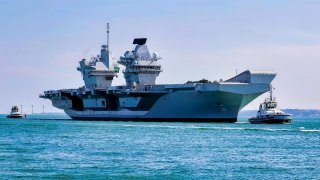The Royal Navy's Aircraft Carrier Nightmare Just Won't End
The UK's Royal Navy faces challenges with its Queen Elizabeth-class aircraft carriers, HMS Queen Elizabeth and HMS Prince of Wales, which have encountered a series of setbacks, including mechanical failures and operational limitations
Summary: The UK's Royal Navy faces challenges with its Queen Elizabeth-class aircraft carriers, HMS Queen Elizabeth and HMS Prince of Wales, which have encountered a series of setbacks including mechanical failures and operational limitations. Recently, HMS Queen Elizabeth experienced a minor fire while docked in Scotland, although damage was minimal and no one was hurt. Despite their combined cost of £7 billion, questions arise regarding their defense capabilities and operational independence, as the Royal Navy struggles with logistical support and an unclear mission for these carriers. Issues with HMS Prince of Wales, such as engine room leaks and mechanical breakdowns, underscore concerns about the reliability and effectiveness of these ships amid broader concerns about the UK's military readiness.
UK's Aircraft Carrier Woes: The Troubled Journey of HMS Queen Elizabeth and Prince of Wales
Much has been written about the Russian Navy's cursed aircraft carrier Admiral Kuznetsov – but the UK's Royal Navy's flattops are proving to be nearly as problem-plagued. The $3.7 billion flagship HMS Queen Elizabeth, which has already been sidelined due to an issue with her starboard propeller shaft, caught fire over the weekend while docked for repairs at Glen Mallan on Loch Long in Scotland.
The damage was reported to be minimal and there were no fatalities or injuries, while no ordnance was involved in the incident.
"A minor, isolated fire on HMS Queen Elizabeth was quickly brought under control and extinguished," a Royal Navy spokesperson told the UK Defence Journal.
Expensive Aircraft Carrier Mistakes for Royal Navy?
The Royal Navy's two Queen Elizabeth-class aircraft carriers were approved in 2007 by then-Prime Minister Gordon Brown. HMS Prince of Wales was almost canceled and scrapped even before it set sail due to concerns over funding, yet, it was determined that axing it would be more expensive than completing it.
HMS Prince of Wales and HMS Queen Elizabeth cost a combined £7 billion, but it is widely accepted the Royal Navy remains unable to adequately defend or operate them independently. The UK's senior service has just one solid stores ship, RFA Fort Victoria, to support the carriers and she is due to be retired in 2028.
As a result, the mission of the Royal Navy's carriers isn't exactly clear – a point made by Tom Sharpe of the UK's Telegraph newspaper, who offered this commentary:
"Our carriers are a great capability but even when they are fully formed, in some faraway time when we have a full complement of UK jets and other aircraft to put on them, they will never rival a US Carrier Strike Group for the breadth of capability and firepower. This doesn't mean they aren’t capable but they aren't as capable as that."
Sharpe further suggested that the Royal Navy's carriers are nowhere near being fully formed and equipped, warning there are gaping holes in the ships' airborne early warning, air-to-air refueling, and solid stores support – which includes food, jet parts, ammunition and ordnance, as well as other goods.
Problems Continue
Though the fire on HMS Queen Elizabeth was minor – and shipboard fires aren't exactly uncommon – it served as a reminder of the problems with the Royal Navy's two carriers.
HMS Prince of Wales languished in a Scottish dockyard – the same one where HMS Queen Elizabeth is headed – after it broke down off the Isle of Wight in August 2022. Since her commissioning in 2019, HMS Prince of Wales has been laid up almost as much time as she's been at sea.
The carrier's problems have been serious and ongoing, putting into question her reliability. The issues began in early 2020, when the carrier suffered a leak in the engine room, followed by the collapse of an accommodation block.
The recent sidelining of the Royal Navy's flagship also comes as UK ministers have warned that the nation isn't sufficiently prepared to fight an all-out war amid stockpile shortages and an armed forces recruitment crisis. The Royal Navy once ruled the waves, now it can barely keep its carriers operational.
Perhaps that is why some in the British government may seek to cut the losses and sell off one of the carriers. The question is who would want to actually buy one?
Author Experience and Expertise: Peter Suciu
Peter Suciu is a Michigan-based writer. He has contributed to more than four dozen magazines, newspapers, and websites with over 3,200 published pieces over a twenty-year career in journalism. He regularly writes about military hardware, firearms history, cybersecurity, politics, and international affairs. Peter is also a Contributing Writer for Forbes and Clearance Jobs. You can follow him on Twitter: @PeterSuciu. You can email the author: [email protected].
Image Credit: Shutterstock.


